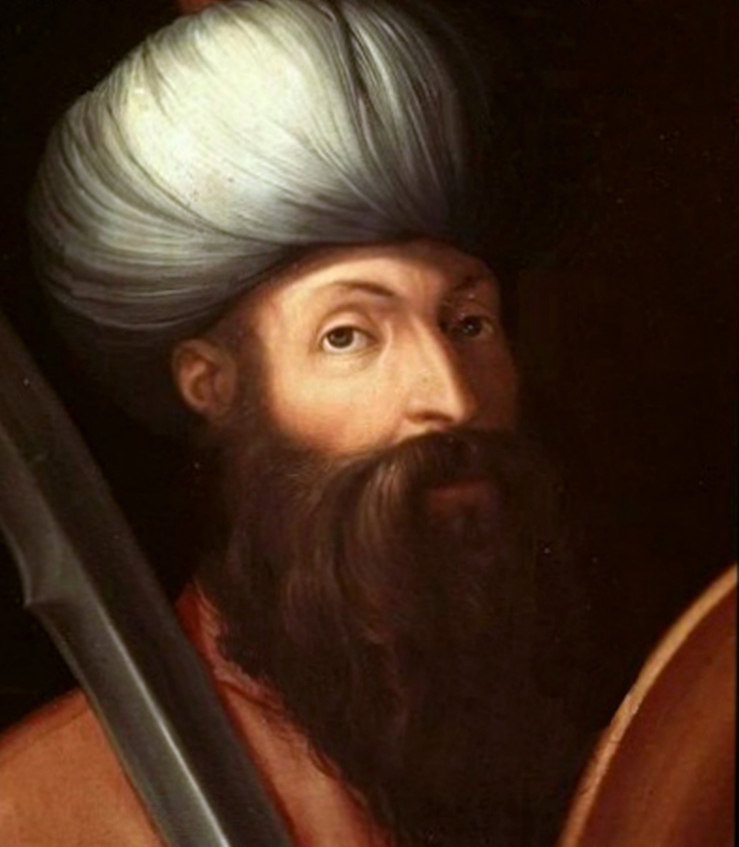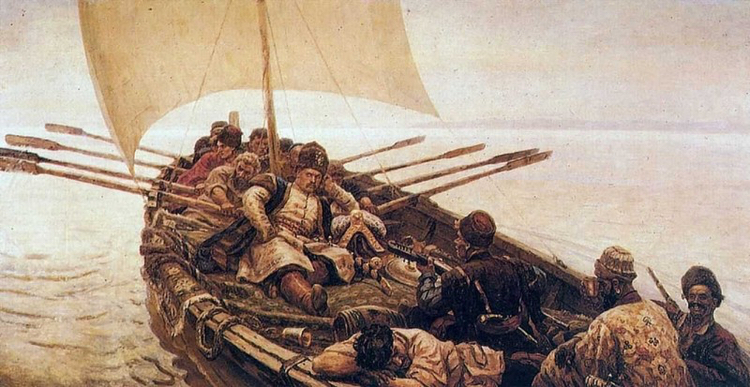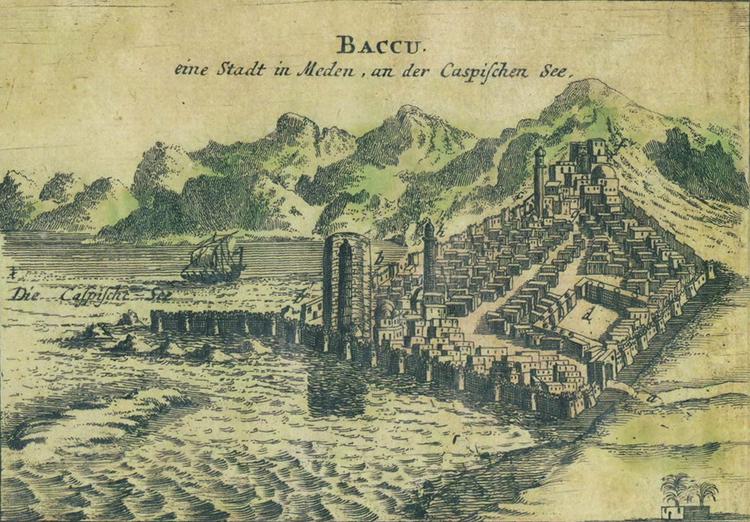The period of the Safavids
The state of Safavid has a special place in the history of Azerbaijan’s statehood.

Shah Ismayil and Shirvanshah Farrukh Yasar.
1541. Tabriz
The existence of the state of Shirvanshah ended with disaster under Farruh Yasar when Sheikh Juneyd and his son Sheikh Heydar from the family of Safavids came out as conquerors and attacked Shirvan. Under Khalilullah I, in 1460 Sheikh Juneyd fell in action and in 1488 the battle with Farruh Yasar Sheikh Heydar was killed. In 1499, founder of the Safavid state Ismail Safavi launched a march against Shirvanshah.
In 1500, he captured Shamakhi and routed troops of Farruh Yasar who lost his life in the battle under Jabani near the reinforced fortress Gulistan.
Despite the heroic defense of Baku, Ismail captured the town in 1501. Baku was reputed to be impregnable fortress surrounded by three lines of mighty walls, which were fenced by the sea on the one side, and brought and deep ditch on the part of land.
Shah Ismail was very interested in capturing the fortress, since Baku was one of the largest towns of Shirvan and the very comfortable port for transit trade in the Caspian Sea. Devoted to the dynasty of Shirvanshah, besieged Baku residents bravely resisted relying on unassailable fortifications and large stocks of food and weapons.

In the reviewed period, Baku, Mahmudabad and Salyan were estate of Gazi bey, son of Farruh Yasar, who kept on resisting in the mountain fortresses of Shirvan. For lack of Gazi bey; it was his wife, heroic and courageous woman who headed the defense of the town. Historians do not mention her name. She ordered to execute an envoy of Ismail who came to suggest her surrender. Abd al-Fattah bey, Baku darugu, who came to see her with threats of Ismail and demands to give in, suffered the same fate. Stubborn resistance of Baku residents forced Ismail Safavi to send new troops headed by Hulafa bey and in the end he had to personally arrive in Baku. Seeing that defenders of Baku were not going to give in, Ismail ordered to sap and explode a large stone inside a tower of the fortress wall. Meanwhile, residents of the town kept on resisting and even held out three days, however, after a strong assault the fortress fell. Safavid troops exterminated scores of residents of the town. In realizing that the resistance was senseless, 70 noble Baku residents with Koran in their hands, swords on their necks and cerements of their backs came to see Ismail and announced about their obedience to him.

Ismail ordered his commander Hulafa bey to immediately seize the fortress and misappropriate treasures of Shirvanshah. Hulafa bey seized a lot of gold and jewelry from Khalilullah sepulcher and sent it all together with precious gifts on behalf of residents of Baku to Shah Ismail.
Following the capture of Baku, Ismail bent his steps to Gulistan, but soon after he had to raise the siege. In 1501, the Safavid army left Shamakhi.
In 1538 Tahmasib I joined Shirvan, including Baku to the state of Safavid.
In 1578, during the Ottoman-Safavid wars, Baku was captured by Ottoman troops. In 1607 the Baku again came under the authority of the Safavid.
Natural resources and military strategic importance of Baku also attracted the attention of Russia.

It is known that, as a result of oppression by feudal lords and arbitrariness by the Tzarist authorities, in 16-17 centuries, in the Russia’s southern outskirts, there appeared Cossack freemen, who were raiding Derbend and the regions along the coast of Azerbaijan. The move of Cossack detachments under the leadership of Stepan Razin southwards was one of such raids. In April 1669, Stepan Razin-led Cossacks invaded the Baku shoreline and ruined the settlement of Mashtaga and took some 150 men, women and children in captivity and stole 7000 sheep. They took all this to Island Chilov near Baku and divided all this among themselves. A legend says that Stepan Razin lived in a cave near the settlement of Sabunchi. Absheron Peninsula and Baku residents kept the Razin’s invasion in memories for a long time.

Baku was drawing Tzarist Russia’s attention as an important port on the way toward Iran and India. In 1715, Peter I sent envoys led by A.P.Volynski to Iran and Azerbaijan to find out what political and economic position of Azerbaijan was, in order to prepare to occupy Caspian littoral areas. In his report, Volynski gives information about Azerbaijan towns and mentions Baku briefly.
On July 18, 1722, Peter I came up to Derbend with a huge army of 79000 cavalries, which had come from onshore, and 22000 soldiers, and 5000 sailors on 270 ships and boats. On August 23, 1722, the Tzarist troops occupied Derbend without a battle.
On August 22, 1722, prior to entering Derbend, Peter I got letters from Baku in Azeri and Persian of similar content with seals attached. Having no sufficient troops, weapons and foods and seeing that resistance is useless, the Baku elite decided to display obedience to secure the town from being ruined.
In order to conquer the southwest coast of the Caspian Sea, Peter I created a special naval expedition. In 1735, according to the Ganja agreement between Russia and Safavid Baku fell under Safavid’s rule again.
During the Safavid period, the economy of Baku was closely connected with oil.
In 1572 Baku was visited by agents of British trading company, who were interested in Baku oil.

Itallian traveller Pietro Della Valle (1618) spoke about great amounts of black oil around Baku; it was cheap and brought lots of income to the shah every year.
Turkish traveller Evliya Chelebi examines and thoroughly describes Baku oil fields in his travelogue called the “Seyahat-name” (“Book of Travel”) while in Baku, in 1647. Here he reports that there are oil fields in seven places around Baku and each of them has its own color: red, yellow, black, etc., but the most valuable was yellow oil.
The travelogue of a German explorer and secretary to the Swedish ambassador Engelbert Kaempfer, who visited Baku on January 6-8, 1683, gives more detailed information on the method of oil extraction and interesting description of the city and its environs.
In addition to oil, one of the valuable products of the Absheron Peninsula mining industry was a good quality salt, which was extracted from Masazir Lake, located in the western part of the peninsula.
Chilov Island, located in the northeastern part of the Absheron Peninsula, was used to catch seals, the skin of which was processed and used as vessels for oil transportation and the fat was used to make soap and oil for lamps.
At the beginning of the 18 century there were several hundred saffron plots around Baku.

found in the Shirvanshahs’ Palace
During the Safavid period, copper coins were minted in Baku. A significant part of the inhabitants of Baku and Absheron Peninsula were engaged in carpet weaving. It is remarkable that in the 16-18 centuries different crafts, especially carpet weaving developed significantly. In Baku, weaving craft also occupied an important place.
Jewelry was one of the significant branches of artistic craft in Baku also.
A significant development of the craft of a bricklayer in Baku must be separately marked. Historical monuments belonging to the 17-18 centuries show that this period of Baku was a heyday of architecture, engraving and other crafts.
Trade operations of Baku and other Azerbaijani merchants with foreign merchants were carried out far beyond the borders of the country. This trade covered such distant countries as India, China, Siberia, Muscovy and a number of Western European states. Trade relations with Tiflis, Iravan and other centers of the South Caucasus also remained.
